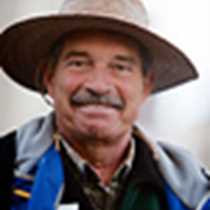Sawyer Glaciers in Tracy Arm, Southeast Alaska
Blue ice, very blue ice. Among the thousands of pieces of ice floating in the cold waters of one of the world’s most beautiful fjords, those that are blue catch our attention first. Sawyer and South Sawyer glaciers are the piece de resistance of Tracy Arm, lying among a monstrous bed of granite rock which originated millions of years ago far off in the mid-Pacific. Both glaciers are active, calving great masses of ice into the tidewater, and both glaciers are receding, like most glaciers of Alaska. Cameras clicked continuously as we sat in our Zodiacs quite near the face of South Sawyer Glacier. Good numbers of harbor seals occupied many of the larger floes, curious yet fearful of our presence. And then the adventure began, as big pieces of ice and larger seracs fell from the face of the glacier with a big boom, called by the natives “sumdum” (white thunder), creating a huge wave in each instance. The sound of the popping growlers and bergy-bits surrounding us made questions to our accompanying naturalist more numerous. Eventually even the extra warm clothes we were wearing began to be insufficient and we returned to our ship.
We then made the return trip to the mouth of the fjord , without any hurry, enjoying the towering gray granite walls, as well as the numerous U-shaped valleys made by the glacier thousands of years ago, as well as a great number of small and large waterfalls. Another interesting observation was that of the vegetational change as we receded from the glacier-face. At first the rock is bare, scoured clean by the glacier in its original advance. The first plants to appear are lichens, together with Sitka alder that is capable of fixing gaseous nitrogen into a salt, absolutely necessary to plants. Many smaller weeds and plants then take hold, as well as willows and cottonwoods, and then the conifers come in, with the Sitka alder first. As miles go on, we can see western hemlock trees appear among the spruce, to eventually become, hundreds of years later in a climax forest, the dominant tree of Southeastern Alaska.
Later in the afternoon we visit Williams Cove , where we commute more with nature, making hikes and using our kayaks, exploring nooks and crannies and a small waterfall, as well as observing wild fowl at the water’s edge.
Blue ice, very blue ice. Among the thousands of pieces of ice floating in the cold waters of one of the world’s most beautiful fjords, those that are blue catch our attention first. Sawyer and South Sawyer glaciers are the piece de resistance of Tracy Arm, lying among a monstrous bed of granite rock which originated millions of years ago far off in the mid-Pacific. Both glaciers are active, calving great masses of ice into the tidewater, and both glaciers are receding, like most glaciers of Alaska. Cameras clicked continuously as we sat in our Zodiacs quite near the face of South Sawyer Glacier. Good numbers of harbor seals occupied many of the larger floes, curious yet fearful of our presence. And then the adventure began, as big pieces of ice and larger seracs fell from the face of the glacier with a big boom, called by the natives “sumdum” (white thunder), creating a huge wave in each instance. The sound of the popping growlers and bergy-bits surrounding us made questions to our accompanying naturalist more numerous. Eventually even the extra warm clothes we were wearing began to be insufficient and we returned to our ship.
We then made the return trip to the mouth of the fjord , without any hurry, enjoying the towering gray granite walls, as well as the numerous U-shaped valleys made by the glacier thousands of years ago, as well as a great number of small and large waterfalls. Another interesting observation was that of the vegetational change as we receded from the glacier-face. At first the rock is bare, scoured clean by the glacier in its original advance. The first plants to appear are lichens, together with Sitka alder that is capable of fixing gaseous nitrogen into a salt, absolutely necessary to plants. Many smaller weeds and plants then take hold, as well as willows and cottonwoods, and then the conifers come in, with the Sitka alder first. As miles go on, we can see western hemlock trees appear among the spruce, to eventually become, hundreds of years later in a climax forest, the dominant tree of Southeastern Alaska.
Later in the afternoon we visit Williams Cove , where we commute more with nature, making hikes and using our kayaks, exploring nooks and crannies and a small waterfall, as well as observing wild fowl at the water’s edge.




